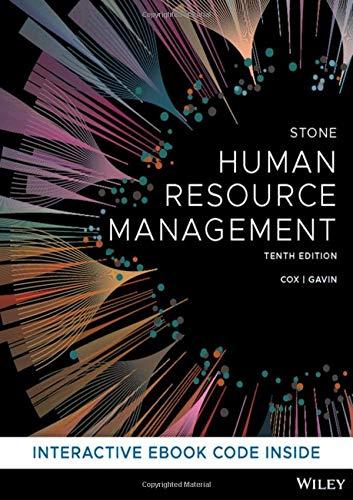You manage a group of five hairdressing salons in the inner suburbs, operating from (10.00 mathrm{am}) until
Question:
You manage a group of five hairdressing salons in the inner suburbs, operating from \(10.00 \mathrm{am}\) until 7.00 \(\mathrm{pm}\) ( \(9.00 \mathrm{pm}\) on Fridays) on a six-day roster - Monday to Saturday. The highest demand for appointments is in the early evenings and all day Saturday.
One of your stylists, Louise, has written to you seeking to be relieved of the need to work after 5.00 pm and any time on Saturday as she has increasing obligations to her three-year old twins and her elderly and infirm parents. She has confirmed that the request is made pursuant to her rights under the NES. You know of at least two other salon staff who might have similar domestic tensions, and neither of them has yet indicated that they are seeking a similar new flexible arrangement - but all the staff are pretty close and they would know of Louise's request. You are apprehensive that conceding to Louise's request will prove to be a 'thin edge of the wedge' and precipitate similar claims from the others in a similar position to her.
The HR manager, as with any other functional manager in marketing, production or finance, is responsible for performance. The position exists foremost to help achieve the strategic business objectives of the organisation. Yet the evidence suggests that few HR managers have a good understanding of the businesses in which they work.
A survey by Fairfax Business Research shows that a significant proportion of managers believe HRM's major contribution is as a provider of information. According to Ulrich, HR people spend \(60-80\) per cent of their time in administrative activities and less than 20 per cent on the roles of strategic partner, employee advocate and consultant on important HR issues. Research by Dainty similarly suggests that many Australian HR managers remain marginalised from strategy formulation. An Australian study, similarly, found that key HR activities (such as recruitment, selection, training, occupational health and safety (OH\&S), employee benefits and industrial relations) were outsourced because of needs to improve quality and efficiency, gain access to specialised knowledge, reduce costs, acquire up-to-date information and to allow HR to focus on its strategic role. Companies such as AMP, ANZ, IBM and Westpac are also embracing robot technology to automate routine administrative tasks in HR and other functions. \({ }^{34}\) An \(H R\) Pulse survey showed that while senior managers overwhelmingly thought HR was critical, less than half felt that HR was functioning effectively in their organisation. \({ }^{35} \mathrm{HR}\) managers, nevertheless, consistently rate their contributions more favourably than do other stakeholders.
Do you think Australians are complacent when it comes to productivity improvement?
Step by Step Answer:

Human Resource Management
ISBN: 9780730385356
10th Edition
Authors: Raymond J. Stone, Anne Cox, Mihajla Gavin





